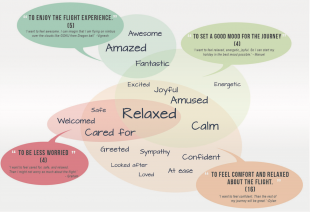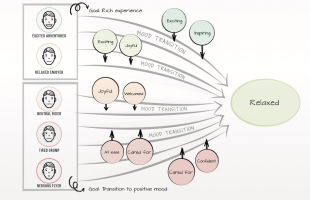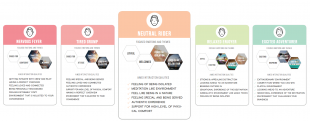Overview
When we are boarding or entering an airplane, sometimes we are excited and sometimes we are tired and grumpy. Depending on our mood, the way we experience the flight will be very different. How can we improve a passenger’s boarding experience so it can be a positive start to the journey? How can the interior and service design change negative moods into positive moods? To answer these questions, an empirical mood study with 30 passengers was conducted. The research outcomes identified mood factors in the air-travel context, and different emotional needs to bring people from a negative mood into a relaxed mood, which is found to be the most desirable mood for long flights. The final concept, Sky Grove, is designed to lift passengers’ mood to a relaxed state by offering an enjoyable and soothing experience.

Three focuses of the project
How does mood influences experience?
One’s experience can be influenced by several factors, and mood plays an important role. Depending on the type of mood we are in, we can perceive the same context differently and this results in us having a different experience. Depending on our mood, we can also have different needs. Therefore, understanding mood types, the different needs caused by different moods, and the relation between mood and influential factors can enable us to effectively deliver an ideal flight experience to the full range of passenger types.
Research outcome
Key to the desired boarding experience: how to lead passengers to become relaxed by creating interactions that meet different emotional needs per each mood.
Five passenger segmentations were identified based on mood. The research results showed that all mood types prefer to be, in the end, relaxed during long-haul flights. However, each mood type has different emotional needs – i.e. different ways of becoming relaxed. Therefore, the boarding experience needs to target these emotional needs. For instance, for nervous people, the experience should focus on evoking a feeling of confidence, and for tired people, a feeling of ease.

Passengers’ desired mood for boarding

Vision for boarding experience focusing on stimulating mood transitions
Mood-driven design tools for the in-flight context: Mood factor map, Ideal entering XP profiles and XP theme cards
Based on the research results, a mood-factor map is created. It shows which of the elements within the context of air travel contribute to which mood. By using this map, designers can choose the factors to consider in their design, depending on the mood they want to evoke or avoid.

Contributing factors to the eight moods in the air travel context
Focusing on the emotional needs and desired interaction of each passenger mood type, ideal entering experience (XP) profiles and design theme card sets were developed. The profile describes the core needs and types of interactions to be included in order to create an ideal experience for each mood type.

Ideal entering XP profile
Sky Grove
Encountering a piece of nature that helps you to set the right mood for a pleasant journey

Sky Grove design overview
The Sky Grove design is focused on passengers in a neutral mood or a negative mood such as tired, grumpy, or tense. Research results show that passengers in these moods tend to be highly affected by their environment. Therefore, the design aims at improving their mood by providing them with a joyful transitional moment as if they were walking into a glade.
The area is designed to give a subtle surprise and a soothing feeling with its nature-like features: a fresh pine scent, the sound of leaves rustling in the breeze, soft and organic forms from the grass-like flooring and the plants in the walls, and the dappled rays streaming through the woodland canopy above. Furthermore, a video visual of the destination and an interactive wall that allows passengers to share their thoughts serve to boost a feeling of anticipation. Sky Grove lets passengers enjoy their flight in a relaxed mood while enabling the airline to successfully deliver a memorable first impression to passengers.



